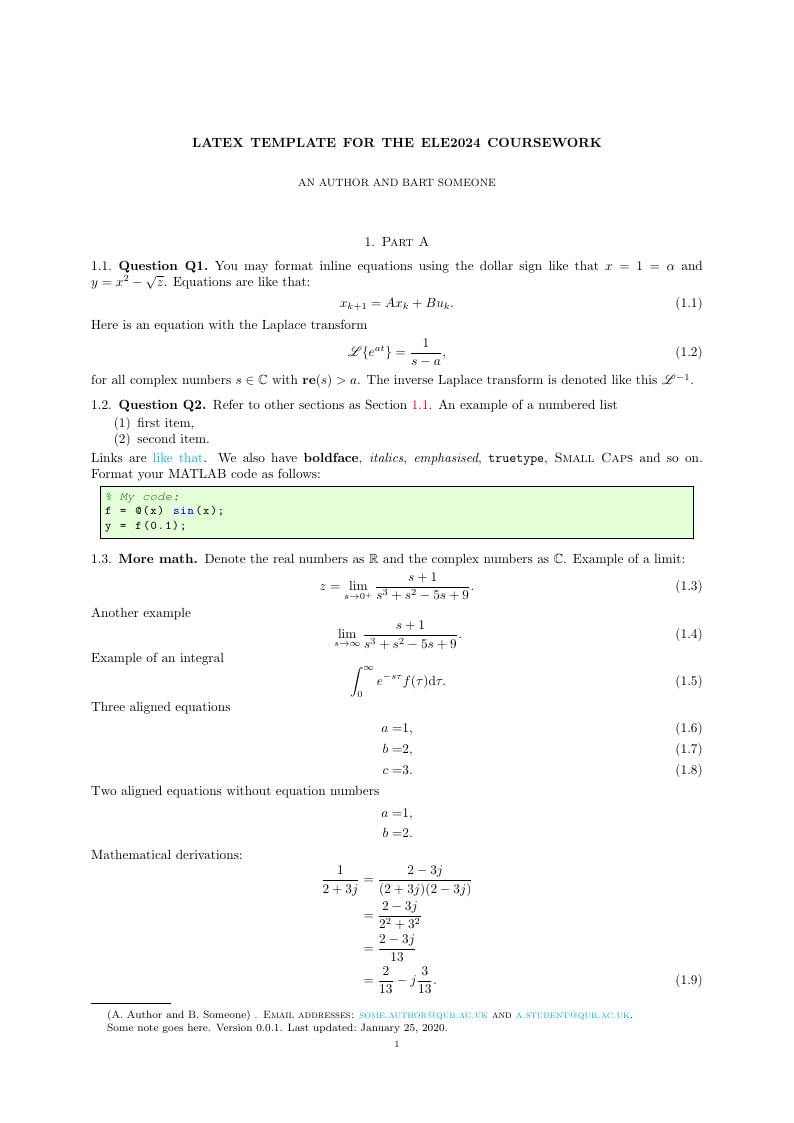
ELE2024 Coursework Template
Author:
Pantelis Sopasakis
Last Updated:
6 yıl önce
License:
Creative Commons CC BY 4.0
Abstract:
LaTeX template for ELE2024 coursework.

\begin
Discover why over 20 million people worldwide trust Overleaf with their work.
LaTeX template for ELE2024 coursework.

\begin
Discover why over 20 million people worldwide trust Overleaf with their work.
\documentclass[a4paper,10pt,reqno]{amsart}
\usepackage[utf8]{inputenc}
\usepackage[foot]{amsaddr}
\usepackage{amsmath,amsfonts,amssymb,amsthm,mathrsfs,bm}
\usepackage[margin=0.95in]{geometry}
\usepackage{color}
\usepackage[dvipsnames]{xcolor}
\input{toc-config.tex}
\usepackage{mathtools,enumerate,mathrsfs,graphicx}
\usepackage{epstopdf}
\usepackage{hyperref}
\usepackage{latexsym}
\definecolor{CommentGreen}{rgb}{0.0,0.4,0.0}
\definecolor{Background}{rgb}{0.9,1.0,0.85}
\definecolor{lrow}{rgb}{0.914,0.918,0.922}
\definecolor{drow}{rgb}{0.725,0.745,0.769}
\usepackage{listings}
\usepackage{textcomp}
\lstloadlanguages{Matlab}%
\lstset{
language=Matlab,
upquote=true, frame=single,
basicstyle=\small\ttfamily,
backgroundcolor=\color{Background},
keywordstyle=[1]\color{blue}\bfseries,
keywordstyle=[2]\color{purple},
keywordstyle=[3]\color{black}\bfseries,
identifierstyle=,
commentstyle=\usefont{T1}{pcr}{m}{sl}\color{CommentGreen}\small,
stringstyle=\color{purple},
showstringspaces=false, tabsize=5,
morekeywords={properties,methods,classdef},
morekeywords=[2]{handle},
morecomment=[l][\color{blue}]{...},
numbers=none, firstnumber=1,
numberstyle=\tiny\color{blue},
stepnumber=1, xleftmargin=10pt, xrightmargin=10pt
}
\numberwithin{equation}{section}
\synctex=1
\hypersetup{
unicode=false, pdftoolbar=true,
pdfmenubar=true, pdffitwindow=false, pdfstartview={FitH},
pdftitle={ELE2024 Coursework}, pdfauthor={A. Author},
pdfsubject={ELE2024 coursework}, pdfcreator={A. Author},
pdfproducer={ELE2024}, pdfnewwindow=true,
colorlinks=true, linkcolor=red,
citecolor=blue, filecolor=magenta, urlcolor=cyan
}
% CUSTOM COMMANDS
\renewcommand{\Re}{\mathbf{re}}
\renewcommand{\Im}{\mathbf{im}}
\newcommand{\R}{\mathbb{R}}
\newcommand{\N}{\mathbb{N}}
\newcommand{\C}{\mathbb{C}}
\newcommand{\lap}{\mathscr{L}}
\newcommand{\dd}{\mathrm{d}}
\newcommand{\smallmat}[1]{\left[ \begin{smallmatrix}#1 \end{smallmatrix} \right]}
%opening
\title[ELE2024 Coursework]{LaTeX template for the ELE2024 coursework}
\author[A. Author]{An Author}
\author[B. Someone]{Bart Someone}
\address[A. Author and B. Someone]{. Email addresses: \href{mailto:some.author@qub.ac.uk}%
{some.author@qub.ac.uk} and
\href{mailto:a.student@qub.ac.uk}{a.student@qub.ac.uk}.}
\thanks{Some note goes here.
Version 0.0.1. Last updated:~\today.}
\begin{document}
\maketitle
\section{Part A}
\subsection{Question Q1}\label{sec:q1}
You may format inline equations using the dollar sign
like that $x = 1 = \alpha$ and $y = x^2 - \sqrt{z}$.
Equations are like that:
\begin{align}
\label{eq:lti_state_update}
x_{k+1} = A x_k + Bu_k.
\end{align}
Here is an equation with the Laplace transform
\begin{equation}
\lap \{e^{at}\} = \frac{1}{s-a},
\end{equation}
for all complex numbers $s\in\C$ with $\Re(s)>a$.
The inverse Laplace transform is denoted like this $\lap^{-1}$.
\subsection{Question Q2}
Refer to other sections as Section~\ref{sec:q1}. An example of a numbered list
\begin{enumerate}
\item first item,
\item second item.
\end{enumerate}
Links are \href{https://google.com}{like that}. We also have \textbf{boldface}, \textit{italics},
\emph{emphasised}, \texttt{truetype}, \textsc{Small Caps} and so on.
Format your MATLAB code as follows:
\begin{lstlisting}[language=matlab]
% My code:
f = @(x) sin(x);
y = f(0.1);
\end{lstlisting}
\subsection{More math} Denote the real numbers as $\R$ and the complex numbers
as $\C$. Example of a limit:
\begin{equation}
z = \lim_{s\to0^+}\frac{s+1}{s^3+s^2-5s+9}.
\end{equation}
Another example
\begin{equation}
\lim_{s\to\infty} \frac{s+1}{s^3+s^2-5s+9}.
\end{equation}
Example of an integral
\begin{equation}
\int_0^\infty e^{-s\tau}f(\tau)\dd\tau.
\end{equation}
Three aligned equations
\begin{align}
a =& 1,
\\
b =& 2,
\\
c =& 3.
\end{align}
Two aligned equations without equation numbers
\begin{align*}
a =& 1,
\\
b =& 2.
\end{align*}
Mathematical derivations:
\begin{align}
\frac{1}{2+3j} {}={}& \frac{2-3j}{(2+3j)(2-3j)}
\notag\\
{}={}& \frac{2-3j}{2^2 + 3^2}
\notag\\
{}={}& \frac{2-3j}{13}
\notag\\
{}={}&\frac{2}{13} - j\frac{3}{13}.
\end{align}
More mathematical derivations:
\begin{align*}
& as + 4 + 2s = b + (8+a)s
\\
\Leftrightarrow{}& (a+2)s + 4 = b + (8+a)s
\end{align*}
Boldface math: $\bm{x}$. Vectors:
\begin{equation}
\bm{x} =
\begin{bmatrix}
x_1
\\
x_2
\\
x_3
\end{bmatrix}.
\end{equation}
Another example: According to Taylor's Theorem:
\begin{equation}
\phi(x) \approx \phi(x_0) + \phi'(x_0)(x-x_0).
\end{equation}
% You can write comments like this
\begin{figure}
\centering
\includegraphics[width=0.6\linewidth]{figures/ode45_1.eps}
\caption{You may of course include figures in your document. It is best to use vector format graphics such as EPS files.}
\end{figure}
\end{document}